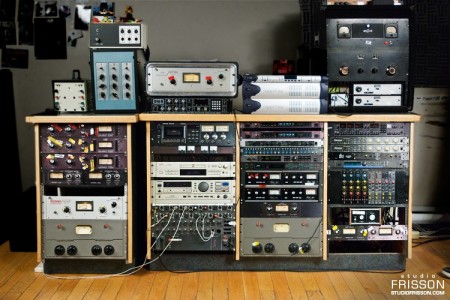
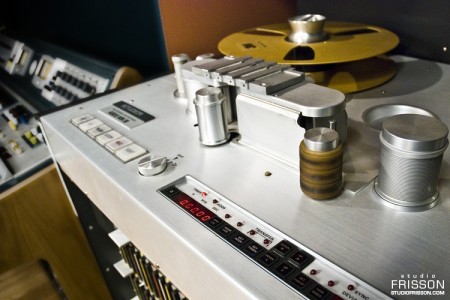
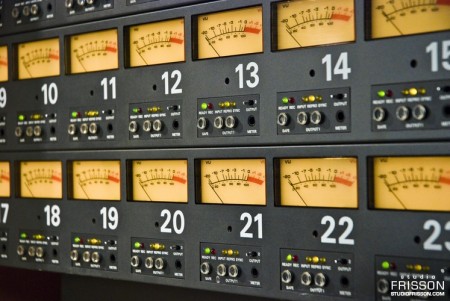
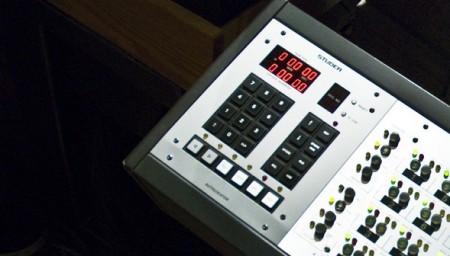
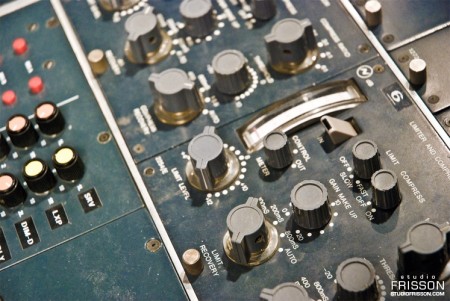
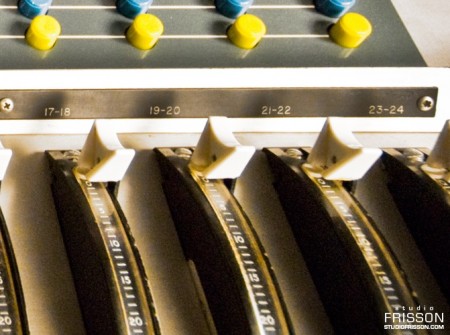
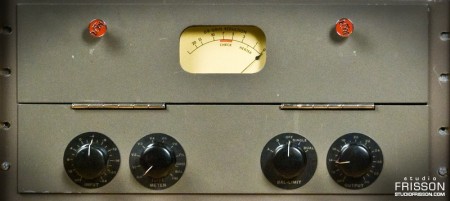
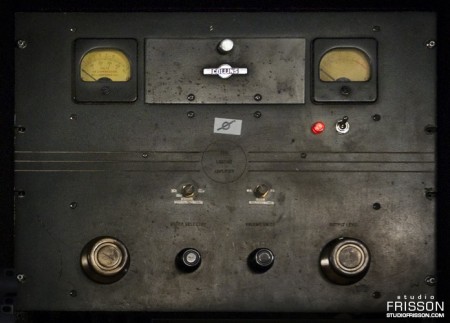
I came across these great photos from Québec-based recording facility Studio Frisson while gear-lusting tonight and was stricken by their quality. Most studios don’t do a very good job of tastefully photographing the facilities so it was refreshing to see these very well executed portraits of some of the most rare and prized recording equipment in the world. Some of the post on the photos is a little synthetic for my tastes, but still nice. Unfortunately the images are watermarked so you’ll have to imagine what they’d look like clean.
Speaking of watermarked photos, I’ve really been getting annoyed by the practice, particularly by good photographers. I get why they’re doing it, but honestly, is the damage it does to your image and composition worth whatever infringement someone could pull off using a 650px, 72dpi JPEG? Just asking for the sake of argument, I can certainly understand the motivation.
Anyways, you may not share my hopeless obsession with analog audio hardware, but you can’t deny the sexiness of these machines and their interfaces. I’ve always found equipment like this a good source of inspiration when designing realistic software interfaces.
Sorry, no mention of the photographer that I could find. If anyone knows please speak up!



While I didn’t take those photos, I can understand how images are often used as promotional pieces and a small watermark (like the one in the Studio Frisson images) can help with brand recognition. The images aren’t used in the context of pure art, they’re being used as marketing/promos.
I don’t watermark my own images, but I can understand how photographers could start doing that on their own images as a way of marketing themselves OR as work for other people to make some money. It isn’t exactly the most lucrative vocation (for the majority) so sometimes you take gigs that aren’t ideal. Granted, if you’re really good, people should be able to recognize your images as your own without any watermarking necessary.
Your argument is based on the assumption that the watermark is damaging. The problem is that has not been established as fact. It’s merely your personal opinion. The watermarks in the photos above don’t bother me at all, and I bet most people didn’t think twice about them. They did not impede my understanding or enjoyment of the content.
Well no matter how you look at it, a watermark is covering up part of the image. I have always felt like people are telling me where the uninteresting parts of their images are, otherwise it wouldn’t be covered up. Seems kind of insecure to me to feel the need to brand yourself on your artwork.
To me, there is something way less intriguing about watermarked personal photos. While I agree that it takes away from the composition, I think there is something about the [initial] anonymity of the photograph that attracts me. In this case it doesn’t bother me really, as it doesn’t distract so much that I didn’t even realize until Scott mentioned it. That being said it frustrates me to see a beautiful photo spoiled by a tasteless watermark. This also isn’t personal work, but for a recording studio, where it serves a more meaningful purpose in my opinion. ‘If these were personal work, I’d prefer sans watermark any day.
I couldn’t resist joining this conversation.
To put it mildly, watermarks remove you from the time and place a photograph is supposed to ‘transport’ you to. They remind you that the actual here and now, marketing schemes and all, have not been left behind. They stifle some of the imagination it takes to study and contemplate an image. You have to purposely try to ignore it to appreciate the image and the wonder it can evoke.
This is merely a case study of form over function. Yes, the image might be more interesting minus the watermark and the ideas it casts on the viewer. However it is more important in this application to remind the viewer that these facilities and machines are courtesy Studio Frisson.
This is where an artist and his ideas of what is ‘proper’ in design should take a break and let things be what they are. In this application this is an advertisement and the copy is equally as important as the image.
Why not put the copyright info in metadata? Or am I missing something?
Think of how many times you’ve come across interesting images that have been re-blogged and re-tumblr’d so many times you can’t find the origin no matter how long you search. Don’t you wish they’d been watermarked?
i put it this way, artists that use internet focused watermarks are scared, uptight control freaks. i never watermark any of my stuff, because, at the end of the day, i know that i have the master, under my bed and on a harddrive…
i want the exposure, and in my eyes, i dont get enough and the last thing i want is to inhibit anyone from sharing my stuff…
there, i said it.
On the topic of analog audio machines moog put out an interesting app called Filtatron. I have to say it’s pretty cool.
http://www.moogmusic.com/news/?cat_id=254
MM
Agreed! The sexiness is undeniable!
That first pic is great. Funny how the Protools hardware looks so out of place among all the older gear. Wonder what protools would look like if it were designed from a purely functional approach and the industrial design was stripped. Thanks for sharing this.
Yeah, I can understand both sides of the argument, but I agree with T Harvey, Joel, and others about it removing you from the image. It does that to me for sure, not matter what the photo is, I instantly conjure up ideas about myspace professional party photos on those fake red carpets with the logo background and the photog’s crazy logo watermarked in the corner. I know that’ pretty unrelated, but that’s the sort of thing that comes to mind for me, knee jerk reaction.
I have seen it done tastefully though, but that’s the rare occasion where the photo happens to also be a good designer and understands balance and restraint.
Will-
yeah man, it’s really sad how ugly PT hardware is. I have an RME interface, and while it’s not as good looking as any of the classic stuff, it at least feels purpose-driven design wise. I think that’s the problem, when you start paying people to design the stuff it ends up being all alien and new school. You have to let the engineers design the box too. That’s who did all of the old school stuff, the guy who designed the internals also designed the interface.
Now I’m not saying the engineer is always the best person to be designing things from a usability standpoint, but most of this stuff does one or two things and that’s it. So really, the goal should just be to design the most minimal interface possible out of the highest quality, most durable materials you can get. And that’s what I felt they were doing back then.
A lot of audio companies (mostly boutique) still follow the old school, engineered design principles though. Particularly companies like API and Neve who were smart enough to stick to their original designs (although they did deviate for a while back in the 80’s when everyone was going digital).
a few years back i was working on a record with Lillywhite. we took some photos that (naturally) went up on blogs and such. a year or so later i saw an interview w/ Steve in a trade mag with my picture in it.
i’ve also seen photos of my studio passed off by others as their own studio. it’s a drag that people do that but it happens. therefore, the (minor) watermark in this case is warranted, i think.
$0.02. great blog.
Watermarking is pretty lame. Like Joel said, it totally removes you from what you’re looking at. Even for the photos above, chances are you’re already at their site and, hopefully, figure out that those are shots of the studio. If someone steals photos like those and says that’s their studio… that’s just comical. Do they plan on getting work from something they don’t have?
It’s an ugly practice. I love the watermarks that have the photoshop plastic or neon filter added for good measure. I’ve never seen a professional (a REAL professional) photographer watermark their images. Only the people who think their shit is hot and need an ego boost will add a watermark. Like Scott said, you’ll see some people who can pull it off nicely. Ben Blood being one of the few.
If someone wants to steal another person’s photos – they’re going to. It’s not like they’re going to get any real work out of it because they clearly don’t have the skill to back it up their theft.
My ex found a photographer to shoot with on Model Mayhem once (lots of watermarks there). She showed me the files of the shoot and she totally got scammed. Luckily it was free but his work was not the work of what was on his profile. Even if you were a true master at photoshop, it just wasn’t the same lines/angles/textures/light. He was some perverted fat man from Pasadena. Hide yo’ kids. Hide yo’ wife.
Maybe it’s just me, but I wouldn’t call a small logo and url in the very corner of an image a “watermark”.
It’s more like branding.
Cool images of cool gear usually tend to spread on the net, so it’s understandable that they want to take the chance to spread their name aswell with them.
That’s unnecessary with bloggers like you who take the time to link back and write about the context of the cool things they discover, but many times in forum and social networks you happen to find similar stuff linked from some image sharing site and posted with just a “wooh cool gear bro” comment, so I’m happy to trade the little visual disturbance of a small logo in the corner with the ability to learn about the source of such good stuff.
Hey, Frisson is where some of AF’s Suburbs was recorded!
These aren’t personal works of art. They are studio shots for a business. Who cares if they are watermarked?
Doesn’t Iso50 watermark each one of his prints/images with his logo?
Unfortunately it’s been known to happen, that professional mastering studios have had their images stolen by some cheap-fast-online-mastering website. Luring a potential client into thinking that the music is being run through rare, expensive analog gear, when in fact it’s just a kid with Fruity Loops and a pirated Waves bundle, trying to make some easy money.
Always based on the premise that you don’t have to show up in person, but it can be done over the internet. – But of course, there are also legit sites doing remote mastering.
If this is the case with recording studios, where the client would actually show up physically at some point to record, I can’t say, but in that context, I can definitely understand the watermark: We actually own this! This is what you get.